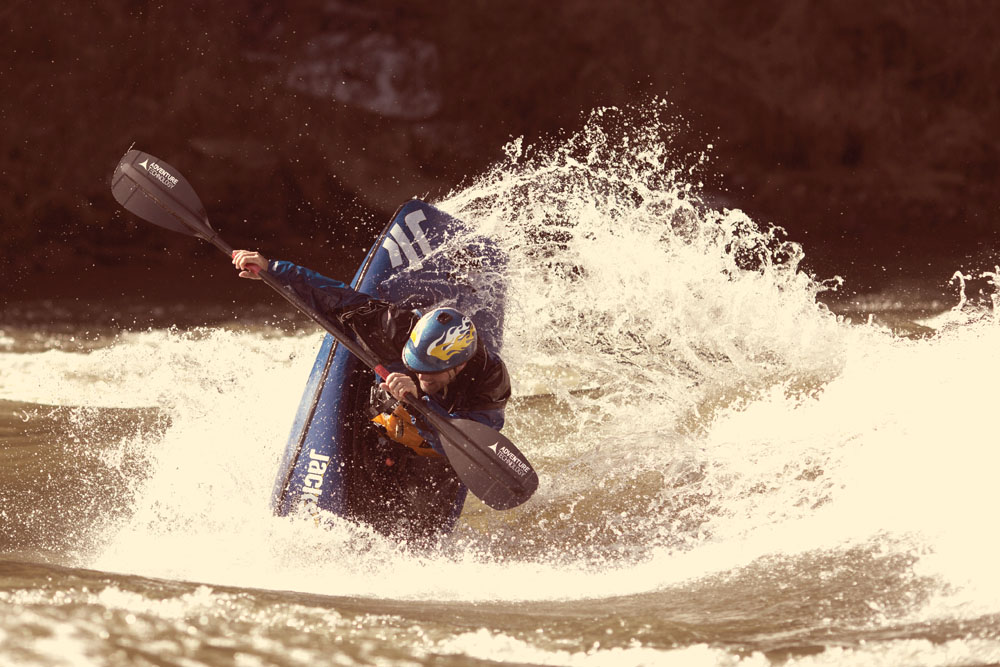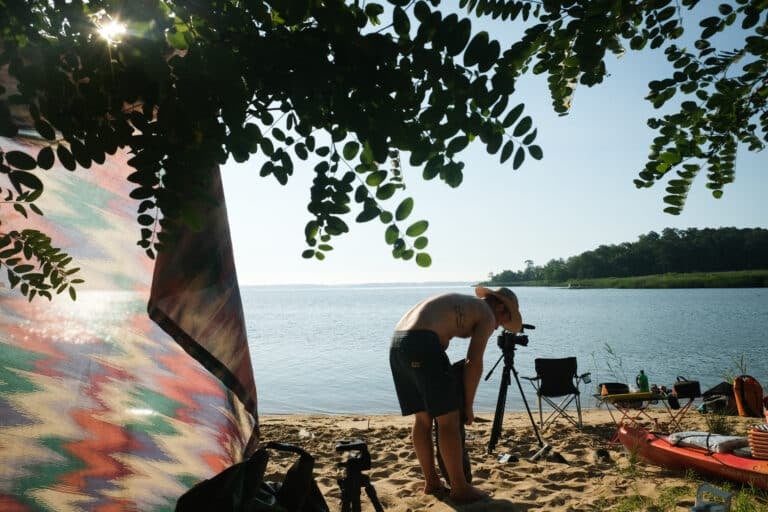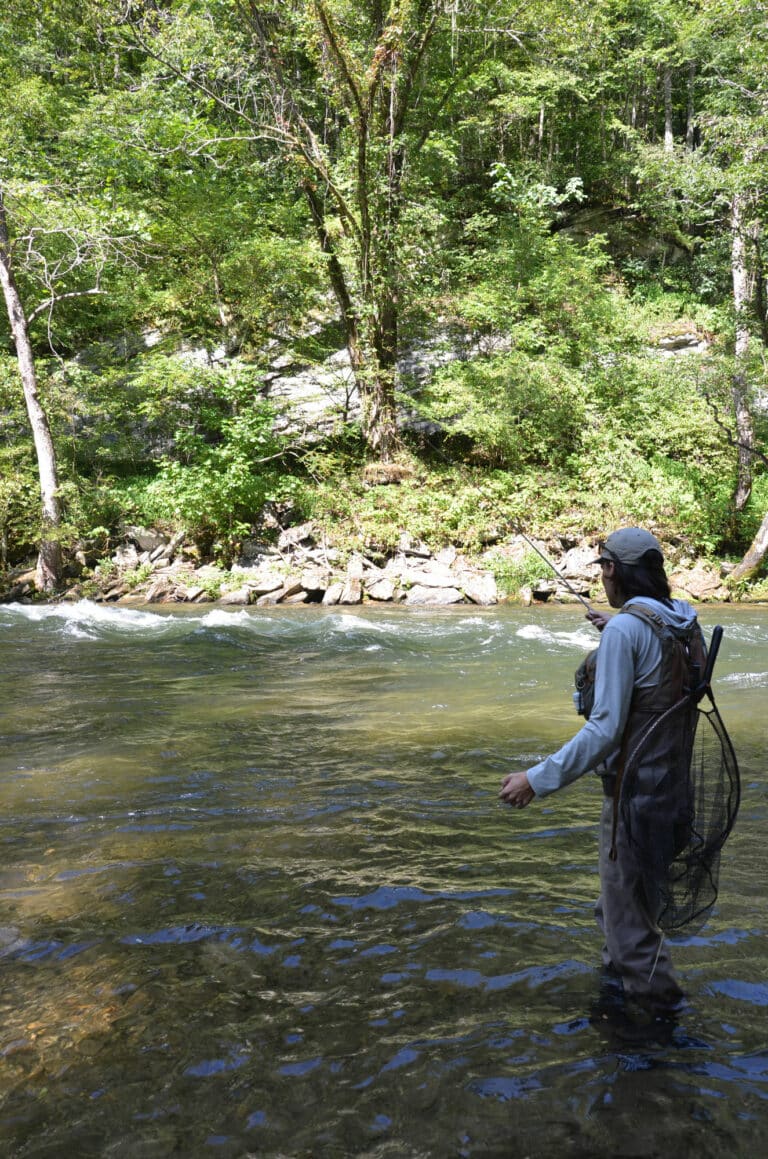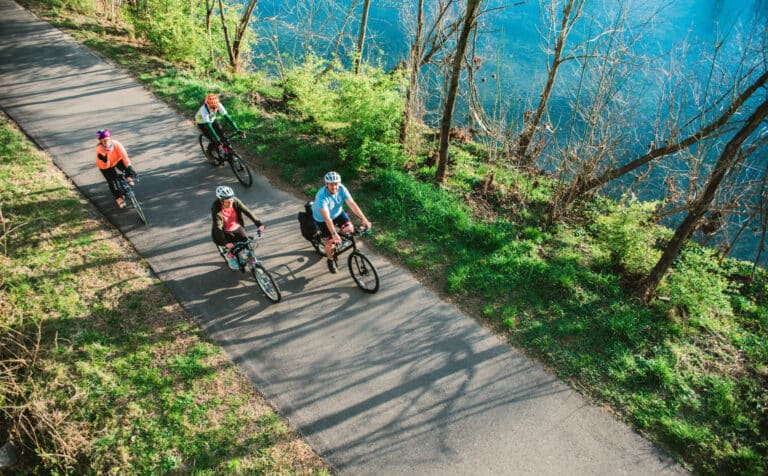We’re all guilty of sneaking in a little YouTube session during a lunch break to check out the latest adventure porn. But what you don’t see in those sick skiing videos of Ingrid Backstrom or the unbelievable biking stunts from Danny MacAskill are the countless times they crashed and burned.
The road to success for four of our top regional athletes was also chock full of bumps and detours. Here are their hard lessons learned and their advice for taking your training to the next level.
FREESTYLE KAYAKING
STEPHEN WRIGHT
Vienna, Virginia
Imagine showing up to the Oregon Cup, one of the premier freestyle kayaking events in the country, with little more than a Prijon kayak, some gear, one friend, and a silly amount of stoke to simply be kayaking. That’s precisely how Virginia’s Stephen Wright made his entry into the competitive freestyle kayaking scene.
The year was 2004, and no one had ever heard of Wright. But that all changed after one of his impressive rides bumped Wright into the top three, second only to Eric Jackson himself.
“I learned a lot at that event,” Wright remembers. “Even though I was competing against the top athletes in the sport, I was just blown away by how nice and supportive they were.”
Wright left a lasting impression on Eric Jackson, who had just launched his Jackson Kayaks. Later that summer, Wright would join the Jackson Team and train with EJ himself at his home in Rock Island, Tenn.
“That was really the beginning for me,” Wright says. “He let me work at the Jackson factory to make a little bit of money, but mostly I just kayaked every day.”
Wright grew up on the banks of the Potomac in the Great Falls area. He always loved the outdoors, but as a kid, his interests were more in backpacking, caving, and rock climbing. It wasn’t until he was 19 years old that Wright decided to take the leap and try his hand at kayaking.
“A friend of mine knew how to kayak and worked at an outdoor shop,” Wright remembers. “He told me they were going to have a sale and that there was a boat at the shop for $300. He told me if I bought the boat and all the gear, he’d teach me how to kayak.”
Wright purchased the boat and all of the gear without ever having sat in a kayak before. His first day on the water, though, Wright knew he’d made a smart decision.
“It was the most fun thing I’d ever done in my life,” Wright says. “I learned how to roll in half an hour and since that day, I’ve only swam maybe five times in the last 17 years [of kayaking]. I took like a duck to water.”
Wright has since gone on to be a four-time U.S. National Freestyle Champion, a two-time World bronze medalist, and a two-time Teva Mountain Games Freestyle Champion. Wright’s also quite the squirt boater, regularly staking podium finishes at the annual Mystery Championships. He’s paddled around the world, from Canada’s Ottawa River to the Nile in Uganda. It’s obvious—Wright’s happy place is on the water.
So how did he take his hobby and make it not only his career but also his way of life? Lucky for you, Wright has a few tips for prospective paddlers.
HAVE FRIENDS WHO ARE BETTER THAN YOU.
Now this may seem like a bite to your self-esteem levels, but according to Wright, paddling with people who are astronomically better than you will only help you learn more quickly, especially if you’re taking the self-taught approach.
EMBRACE THE UNKNOWN.
If you want to throw loops in the hole, stop flat spinning. Spend your time practicing the tricks that you’re not good at instead of continuing to do what you already know how to do. This seems like a pretty basic concept, but you’d be surprised how many kayakers cartwheel until they’re too dizzy to roll instead of flailing at their Phonics Monkeys. Failing is good—it means you’re trying hard.
GO BACK TO THE BASICS.
Each time you get on the water, spend a little time practicing fundamental kayaking and freestyle skills like front strokes, backstrokes, sweeps, and braces. If you do this every time you paddle, you’ll target good habits and develop new skills much faster.
GET COMPETITIVE.
And not just in competitions. Play competitive games with your friends when you’re paddling. The game HORSE can be applied to most every sport; freestyle kayaking is no exception. You can also set challenges for the group—who can do the most tricks in 30 seconds or who can get the most air.
HAVE FUN.
While kayaking is Wright’s career, he’s made an effort to separate his self-imposed expectations from his genuine love for paddling. “One pitfall of aspiring competitive kayakers is thinking that they’re going to make a lot of money kayaking, which just doesn’t happen to anybody, even the few of us who get paid by sponsors,” Wright says. “We live very inexpensive lives and we do it because we love it.”
“Feeling as though your competitive results are a measure of your self-worth as a kayaker is dangerous,” he adds. “The people who last in this sport are people who are able to enjoy learning and accomplishing personal goals rather than worrying about where they place in competition.”
Regional Rodeos
Maryland Chute Out
Washington, D.C., Aug. 2015
For the past 17 years, the MD Chute Out has attracted some of the most talented up-and-coming playboaters in the region, a number of whom have gone on to compete on the U.S. Freestyle Kayak Team.
Tri-Cities Nolichucky Hometown Throwdown
Erwin, Tenn., Summer 2015
Pending water levels, the Tri-Cities HTTD is held at either the Jaws rapid or at Big Rock and goes throughout the summer. This is where Pyranha paddler Mike Patterson cut his teeth, so don’t be surprised if there’s someone in a Jed showing everyone up—it’s probably Patterson.
World Kayak Hometown Throwdown
Pigeon River, Tenn.—June 2015
Fun and free and open to everyone, this HTTD event is aimed at getting more people on the water trying their hand at playboating and boater cross.
ROAD CYCLING
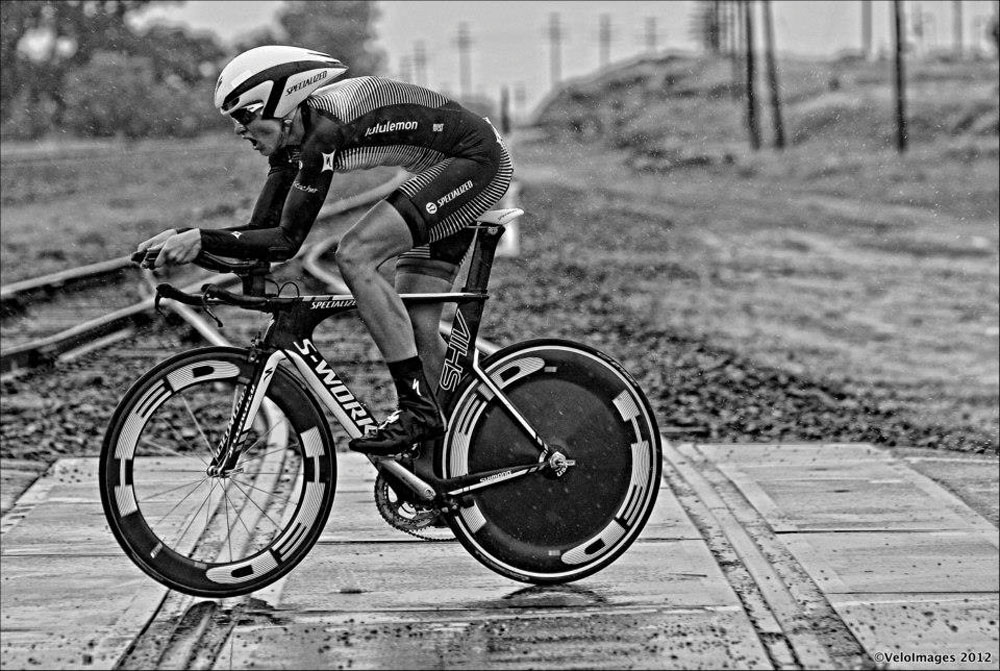
ALLY STACHER
Horse Shoe, North Carolina
There are few people in this world who would stick with a sport that, upon the first time trying it, ended their day with a trip to the hospital and a broken ankle. Ally Stacher, though, is one of those few people. A competitive wrestler throughout high school and most of college, Stacher is used to a little struggle, a little pain. Perhaps it’s those fundamental characteristics that have earned her a reputation for being one of the best domestiques in the women’s professional cycling circuit today.
“Cycling has taught me to work hard,” Stacher says of her rather short career in professional cycling. “That and how to be a part of a team. When one person wins, we all win.”
In the spring of 2009, Stacher joined the U.S. National Team. Though she’d spent the majority of her college career wrestling, she had started cycling regularly on her trainer after breaking her elbow at a match. She eventually made the switch to cycling full-time midway through college and was offered a scholarship to Lees McRae to be part of their up-and-coming cycling team, an opportunity she jumped at. Despite a couple years’ experience of racing, when she joined the National Team, she was still a rookie at best. Stacher didn’t let that stop her, but she will be the first to admit the learning curve was, and continues to be, a steep one.
“During my first trip to Europe on the National Team, one of the girls told me, ‘if you quit a race, you get sent home,’” Stacher says. “I was so scared of dropping out or quitting a race that I decided I’d never do that. But, then I got dropped in the first 10K of the race.”
Once she got dropped, Stacher says she tried in vain to find the finish line and spent the entire day and evening riding the labyrinth of streets, desperately riding to make it to the finish before the race was over. Finally, well after the race was over, two-time world champion and the winner of the day’s race Kristen Armstrong drove around and found Stacher aimlessly wandering on her bike.
Though no doubt a humiliating first experience, Stacher didn’t retreat from the challenge. She trained harder, rode faster, and interpreted everything as a learning opportunity, even when she made a wrong turn once during a criterium race and clotheslined herself off the bike. Her grit and dedication didn’t go unnoticed, though. In 2010, she joined the Webbcor Professional Cycling Team, her first official contract, and just a year later, Stacher signed with the elite HTC-Highroad team.
“You either sink or swim in competitive cycling,” Stacher says, “so I put on some floaties and learned how to swim in deep water.”
Though HTC-Highroad eventually dissolved as the largest men and women’s cycling team in the world, Stacher stayed with the same crew of 10 women. Together, these ladies now form Team Specialized-Lululemon, the fastest women’s team in the industry today. In the team’s first year on the road in 2012 they won over 60 races and finished the season as World Team Time Trial Champions.
Stacher’s well on her way to becoming a reputable domestique like the famous George Hincappie, Lance Armstrong’s right-hand-man and the only rider to assist Armstrong in his seven now-null Tour de France victories. Stacher has helped her team take the gold at La Flèche Wallonne, a prestige classic in Belgium, as well as other races around the world like the China World Cup and La Route de France Internationale Féminine.
Stacher’s competed in over 14 different countries, from Slovakia to Canada, and has even held her own as a competitive mountain biker. Just this past year, Stacher joined the Queen of Pain herself, six-time World Champion and four-time Leadville 100 Champion Rebecca Rusch, to win two of the seven stages in the 2014 Brasil Ride.
“You learn to suffer even more when you get that fire in your belly,” Stacher says. Here are five ways to stoke the fire.
DO GROUP RIDES.
Whether it’s mountain biking or road riding, learning to ride around people is going to introduce you to people who can help get you where you need to be. From learning how to train efficiently or how to fuel properly or even what to wear, riding your bike around other people is, according to Stacher, “super valuable.”
EAT ALLY’S BARS.
Stacher’s a little biased on this one – not only is she a professional cyclist but she also happens to be an entrepreneur. Her company, Ally’s Bars, produces energy bars based from sweet potatoes and other wholesome, natural ingredients. She says fueling right is key for putting in long miles.
“If you don’t eat while you race, you might as well consider your race over,” Stacher says.
MOTIVATION IS KEY.
Athletes require a notable amount of internal motivation and dedication to turn their passions into a lifestyle and a career. It’s not easy, and requires a lot of dedication, but wherever you find motivation, use it, harness it, and you’ll only be successful.
DON’T QUIT.
Don’t quit a race. Don’t quit a training session. Don’t quit eating well. Just don’t quit. Ever. According to Stacher, “if you drop out for health issues or an injury, that’s one thing, but if you quit because it’s too hard, I don’t feel bad for you. Once you learn how to quit, it’s easy to keep quitting.”
GET A COACH.
Stacher works with Colin Izzard of Carmichael Training Systems (CTS) in Brevard, N.C. She says it’s important for athletes to have someone they can bounce ideas off of when it comes to their training load, work load, even daily life stress load.
“Every top rider has a coach and their coach is their everything,” Stacher says. “If you want to excel in a sport, find a coach that’s going to train you to meet your goals.”
STACHER’S FAVORITE CYCLING EVENTS
Parx Casino Philly Cycling Classic
Philadelphia, Penn., June 2015
A one-day, USA Cycling professional race, this might not necessarily be for everyone but it’s sure to draw the world’s most elite riders to the eastern corner of Pennsylvania.
Volkswagen USA Cycling Professional Road and Time Trial National Championships
Chattanooga, Tenn., May 23-25, 2015
For the third straight year, the National Championships return to the Scenic City to test the top athletes in the country. The course winds through downtown and over Lookout Mountain, an icon of the city.
North Carolina Grand Prix
Hendersonville, NC, December 2015
As the first Union Cycliste Internationale (UCI) sanctioned cyclocross race ever held south of the nation’s capitol, the Grand Prix is just one example of North Carolina’s rapidly growing cyclocross community.
[nextpage title=”Page 2″]
CLIMBING
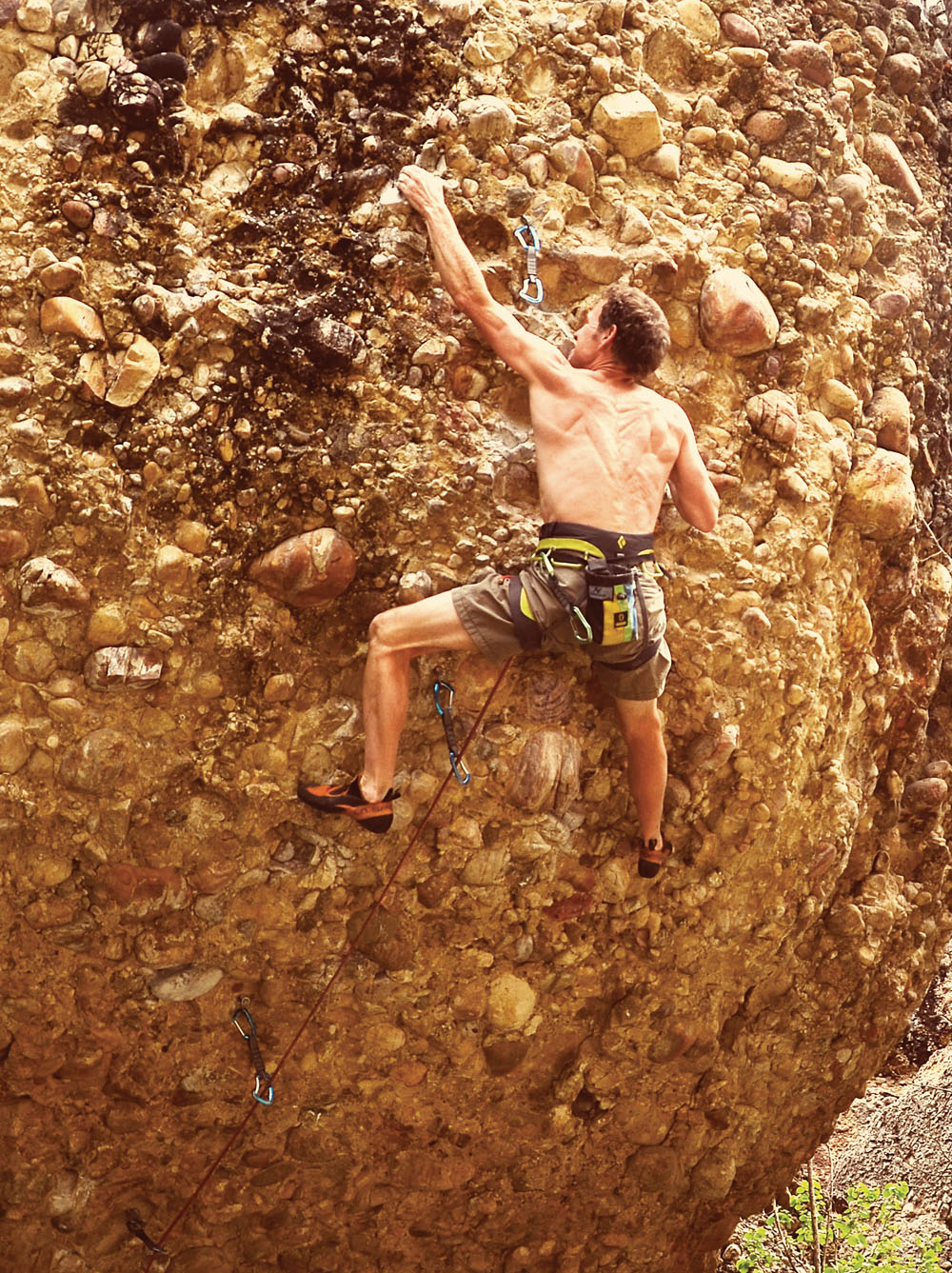
ERIC HÖRST
Lancaster, Pennsylvania
The Hörst family name is legendary among rock climbers in the Mid-Atlantic. If aspiring 5.12 climbers aren’t sleeping with Eric Hörst’s training bible, “How to Climb 5.12,” they’re staring up in awe at his two sons, Cameron and Jonathan, both of whom have already made a name for themselves in the climbing world. Just last year, Jonathan became the youngest climber in the world to redpoint (free-climb a route sans falls, after any amount of rehearsal) a 5.14a. He was just 10 years old at the time.
“Seeing Cam and Jon do what they do has been a little bit of a reawakening for me,” Hörst said in an interview with EPIC-TV last year. “I feel like I’m chasing them now.”
But Hörst, now almost 50 years old, has certainly not shown any signs of slowing down. He still regularly climbs 5.13 routes, and has been climbing at that level for over two decades. Where the climbing community today now has access to Hörst’s seven books on training and climbing in the Mid-Atlantic, Hörst grew up during a time when climbing beta came by word-of-mouth or hardly existed at all.
“Back in those days it was trad climbing,” Hörst says. “There were no sport routes yet, so leading 5.11 trad on marginal gear at Seneca, the Gunks, and in Colorado was pretty rad for a 16 year old.”
By the time Hörst was in his early 20s, he was regularly putting up first ascents of 5.12 and 5.13 sport routes (some of which were the first sport routes ever) throughout the Mid-Atlantic. During his time at Pennsylvania State University, Hörst became obsessed with not just climbing but also the exploration of climbing. He started visiting Bellefonte Quarry near campus and putting up new routes like Power Windows, a 5.12d sport route, and SDI Crack, a 5.12c trad climb.
Hörst is regionally known for being one of the early pioneers of climbing in the New River Gorge. With his friend and equally renown climbing partner Rick Thompson, Hörst helped to establish the Bubba City crags which now rank among the most popular in the gorge. In total, Hörst established close to 200 routes at the New, among those Diamond Life (5.13a), West Virginia’s first 5.13 climb, and Just Send It (5.13b) at Endless Wall.
“I think most athletes want to train and progress in their sport—as a youngster that was my MO as a baseball player, gymnast, and cross country runner,” Hörst says, “so as I got into climbing during my high school years, it was natural for me to train and push myself to climb as hard as I could.”
As Hörst got older, he wanted to harness that passion for improvement and share his knowledge with other climbers. His books include Training for Climbing: The Definitive Guide to Improving Your Performance and Maximum Climbing: Mental Training for Peak Performance and Optimal Experience. From footwork technique to fingerboard exercises and mental approach, Hörst has formulaically broken down the sport of climbing in hopes that his nearly four decades of climbing experience can help others step up their game.
Though oftentimes a season that sees more couch time than crag time, winter can be a great excuse to get back to the gym and focus on strength and technique. Hörst gets physical with his tips for peak performance—practice these six tips three days a week and Hörst says, “I guarantee you will be climbing harder in the spring.”
DOWNCLIMB.
Try to downclimb as much of the route as possible rather than simply lowering off. Why? Initially, you’ll find downclimbing to be difficult, awkward, and very pumpy. As your hold recognition improves, you’ll find downclimbing a route often feels easier than ascending it in the first place. This is because your eccentric (lowering) strength is greater than your concentric (pulling) strength, and due to the fact that by leading with the feet (while downclimbing), you learn to maximally weight them and conserve energy.
MAKE IT RANDOM.
Set out to climb a series of widely varying route types in rapid succession. A commercial gym with many different angles, a few cracks, and a roof or two is ideal. Team with a partner and toprope ten to fifteen routes of different character over the course of an hour. The first route might be a vertical face, the next a slab, the third a fingercrack, the fourth an overhanging pumpfest, the fifth a handcrack, the sixth a roof route, etc. This rapid recall of a wide range of techniques is skill training at its best.
GO FAST.
Climbing quickly is primarily a function of skill, not strength or power. It’s best to engage in speed training on a moderate route or some climb that you’ve got wired. Send the route several times with each ascent slightly faster than the previous. As an estimate, strive to climb about 10 percent faster on each successive ascent, but back off at the first sign your technique is suffering.
WEIGHT YOUR PULL-UPS.
Hypergravity training is a powerful strategy for boosting pull-muscle strength. Wear a weight belt (or hang weights from the belay loop of your harness, enough to limit you to just 5 to 8 reps) while doing two to four sets of pull-ups.
LEVER-UP.
Climb up (or jump or get boosted) to a large jug hold on the roof of a bouldering cave. Beginning from a straight-armed hang, pull up half way (elbows at 90 degrees) then forcefully drop your head and shoulders back and lift your feet upward to latch one foot onto a roof hold as far as possible. Match feet on the hold and then relax your core as much as you can without losing the foothold. Now release your feet and return to the straight-armed starting position. Do 6 to 10 repetitions.
BEEF YOUR CRIMP STRENGTH.
Using a fingerboard edge, do three 7- to 10-second hangs each followed by just 50 to 53 seconds of rest (each hang-rest rep is exactly one minute). Do three sets of three hangs with a three-minute rest between each set.
Test your strength at these top climbing events in the Southeast:
Triple Crown Bouldering Series
Horse Pens 40, Ala., Stone Fort, Tenn., Hound Ears, N.C., and Rumbling Bald, N.C., Oct. thru Dec. 2015
With the added Rumbling Bald location, this bouldering competition series really hits the best spots in the Southeast. Climb hard, meet cool cats, and support the Carolina Climbers’ Coalition!
Dyno Competition
New River Gorge, W.Va., Sept. 2015
As part of the Craggin’ Classic, this dyno comp is held at night on the American Alpine Club’s (AAC) new campground outside of Fayetteville. Fuel up beforehand with some community-made grub and meet New River Gorge climbing legends Gene and Maura Kistler and Kenny Parker.
The Chatt Town Throw Down – Redpoint Bouldering Competition
Chattanooga, Tenn., Aug. and Sept. 2015
Rock/Creek and Element Climbing partner to host this redpoint bouldering competition, a two-part series held at the end of summer.
TRAIL RUNNING
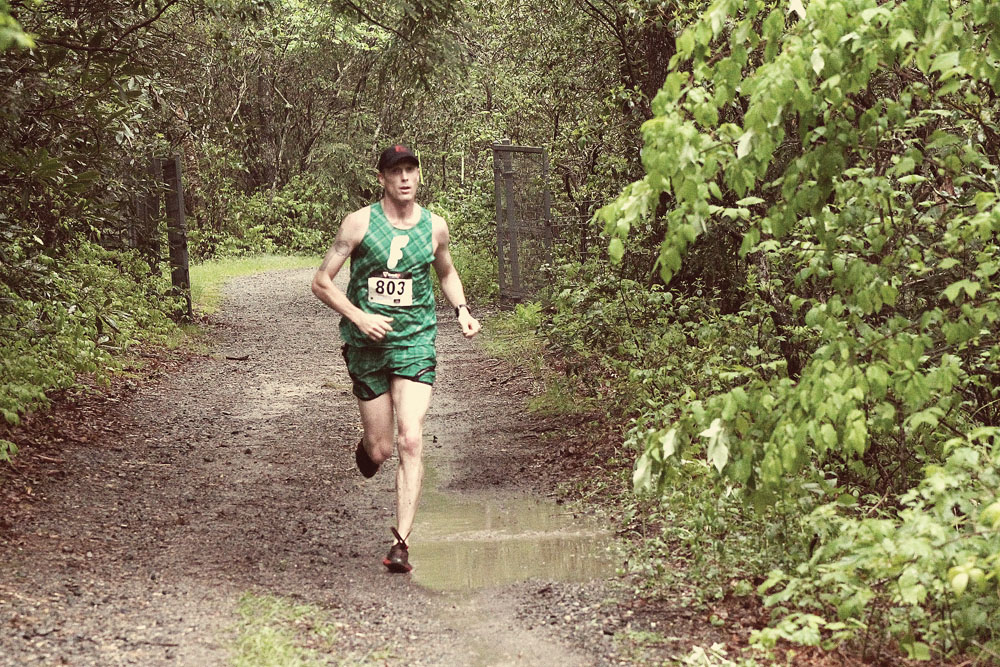
AARON SAFT
Asheville, North Carolina
Longtime runner and owner of the Asheville-based running store Foot Rx, Aaron Saft originally began his foot-hoofing career as a 14-year-old kid playing soccer in Middletown, N.Y.
“I realized in soccer I was actually a better runner than I was a soccer player,” Saft says, laughing.
The kid had a knack for running—there was no question about that. Saft topped out his high school running career with a 2nd in the two-mile as part of the All-American Indoors track and field division. Saft continued to run throughout college for North Carolina State University, joining the Wolfpack team for six track and field Atlantic Coast Conference (ACC) titles and five cross country ACC titles. He’s known regionally for setting a course record at the DuPont Forest Trail Marathon in 2007, the site for the men’s U.S. Track & Field national trail championship. He’s also represented the United States at the North American Central American Caribbean (NACAC) mountain running championships in Mexico, the world long-distance mountain running championships in England, and in various races all over the country from Oregon to New Hampshire.
“Running has taught me that there’s always more potential out there,” Saft says. “There’s potential for growth, potential for improvement, and what’s awesome is that you can pursue a career out of your passion and make a life out of something you enjoy.”
Saft has certainly carved out a lifestyle for himself that centers around all things running. Around 2006, Saft opened up his running shop Foot Rx in Asheville to serve the growing population of runners in town. From “$5 5Ks” to longer races like the Daniel Boone Be Prepared 15K and the DuPont 25K, Saft organizes a wide variety of races every year with the goal of raising money for local charities and giving back both to the region and to the sport that has so positively shaped his life. He also runs a youth running program in an effort to get kids introduced to running earlier in life.
“I spent seven years of my life as a coach working with youth specifically,” Saft says. “I love engaging with young people and working with them and seeing them try to reach their potentials.”
For up-and-coming runners, reaching that potential isn’t necessarily an easy task. Often, despite feeling at the peak of their physical fitness, runners can actually reverse their progress if they’re not careful. Saft offers the following five tips for runners who are looking not only to up their game but to also sustain a healthy running career.
BE FLEXIBLE.
Have a well-rounded program and incorporate not only running but also strength and flexibility in order to truly progress in your running. Make it part of your weekly training program and stick to it.
TAKE A BREAK.
Every runner needs rest. Let the body recuperate. The rule of thumb? Whatever distance your race is, give yourself a day per mile. So, for example, if you do a marathon, take approximately three weeks of rest. That doesn’t mean you can’t run but don’t do things that require exertive effort, unless you’re trying to put your body out of commission, which is exactly what Saft did after winning the national trail championship at DuPont State Forest.
“I ran at the infamous Shut-In Ridge Run three weeks after that marathon,” Saft says. “I actually felt great for Shut-In, had a great race, had the third fastest time in Shut-In history, but after that my body was just shot. I couldn’t recover because I had two major efforts within two weeks and it was simply too much. Let that body recover.”
FUEL PROPERLY.
Make sure you’re getting good calories back in your body. Everything in moderation, especially junk food. Try to avoid artificial or processed foods. The night before a race, try not to overdo the carbs—it can make you feel bloated. Even more important? Don’t try anything new the day before or the day of your race—Saft says he learned this one the hard way.
“Two weeks before I ran the Mount Washington road race, I had throat surgery and my diet was restricted to liquids, which, obviously, I’m not used to,” Saft remembers. “Race day came and I needed to get calories into my system, so I had a smoothie that morning, which I never do. The first four miles of the race my stomach was absolutely killing me but I finally let out a burp that allowed me to feel good enough to keep running.”
RESPECT THE THRESHOLD.
Once you start to gain fitness, there’s a delicate balance between just enough and too much. Keep a log of how you’re feeling, how much you’re running, and how you’re recovering from major efforts to help mitigate crossing into the red zone.
GO MOUNTAIN BIKING.
For Saft, who lives just three miles from Pisgah National Forest, mountain biking provides the perfect way to cross train. “As I’ve gotten older, I’ve realized that cross training gives your body a break from the repetitive motions of running.”
SAFT’S FAV RACES
Tsali Frosty Foot
Robbinsville, N.C., Jan. 17, 2015
Part of the Yeti or Not Winter Trail Series, this no-frills race takes place the Tsali Recreation Area trail system with 30K and 50K options.
Springmaid Splash 5K/10K
Spruce Pine, N.C., Aug. 22, 2015
Located on the scenic grounds of the Springmaid Mountain Resort, this course is challenging, wet (you cross the river four times), and a heck of a lot of fun and a great way to end the summer.
Eastern Divide 50K
Pembroke, Va., June 20, 2015
Beginning at the Cascades and ending at Mountain Lake, this 50K is burly. •
